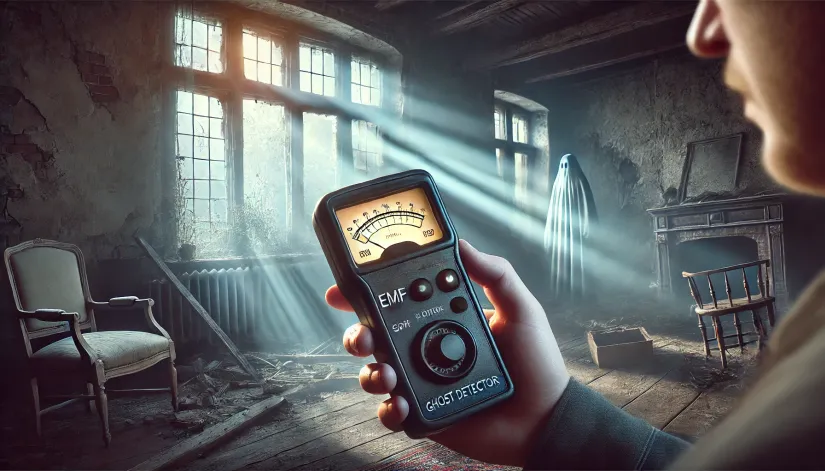Getting ready for your first paranormal investigation but unsure how EMF ghost detectors work? Don’t worry, you’re not alone. EMF meters have become one of the most talked-about tools in ghost hunting. And for good reason.
However, the key is understanding and knowing how to use them effectively in the field.
So, how do EMF ghost detectors work? And why do so many ghost hunters use them while skeptics are still on the fence?
Let’s find out.
In this article:

What Are EMF Meters?
EMF (Electromagnetic Field) meters are specialized devices that measure fluctuations in electromagnetic fields. And an important tool in your ghost hunting equipment kit.
Sounds complicated. But think of these fluctuations as either electric, magnetic, or radio frequency/microwave radiation.
These fields are everywhere—in your home, at work, even outdoors—emanating from devices like microwaves, power lines, and cell phones.
In ghost hunting, the purpose of these detectors is to pick up sudden, unexplained changes in these fields. Why is that important during a paranormal investigation? Because it could indicate the presence of a spirit.
The idea is straightforward: If a ghost is in the room, it might disturb the local EMF levels, causing an unexpected spike or drop.
How do EMF Ghost Detectors Work?
As mentioned above, EMF detectors measure electromagnetic field fluctuations in the environment.
These fields are pervasive in our environment. They can originate from both natural and man-made sources. For example, the Earth’s own magnetic field is a natural source. Power lines, electrical wiring, and wireless devices (like smartphones) are all man-made EMF sources.
EMF meters can pick up not just consistent background EMF levels but also sudden, unpredictable spikes. These anomalies—which we can’t easily explain—drive the speculation that they may be linked to paranormal activity.
Components and Technology
How effective an EMF meter is largely depends on its internal components. Particularly the sensors responsible for detecting electromagnetic fields.
These sensors can convert EMF fluctuations into electrical signals. Next, the device measures and displays the data as readings.
Most EMF ghost detectors use either a 1-axis or 3-axis sensor.
1-axis sensors are the more basic type. Basically, you have to rotate the device to get accurate readings.
Unfortunately, that can be a hassle when dealing with fast-changing conditions. If the source of the EMF is not aligned with that plane, the detector might miss it unless you rotate the device correctly.
On the other hand, the 3-axis sensor (like the one in the Trifield TF2) is more forgiving—it picks up EMF levels in any direction (in all three dimensions simultaneously—X, Y, and Z axes).
So, a 3-axis sensor EMF ghost detector can pick up readings no matter how it is oriented.
Common Models
Planning your next ghost-hunting adventure? EMF models like the Trifield TF2 and Cornet ED88T are must-haves.
The Trifield TF2 is a 3-axis sensor model many beginners and seasoned ghost hunters use. It’s a great tool because it can measure all three types of EMF radiation—electric, magnetic, and radio frequency.
The Cornet ED88T is another top choice. Some prefer it for its detailed frequency readings and the ability to record the last 30 measurements. Its data logging feature can also help track EMF activity over time, so you can easily correlate spikes with specific events or locations.
In addition to these models, the K-II EMF Meter and the Ghost Meter Pro are also popular among paranormal investigators.

How to Use an EMF Ghost Detector: Practical Examples
What better way of learning how EMF ghost detectors work than with some practical, no-nonsense examples in, let’s say, a real ghost-hunting scenario?
Step 1: Get a Baseline Reading
Before you jump into any sort of paranormal investigation, get a baseline EMF reading of your environment. Think of this as your control—by knowing what’s “normal” in terms of electromagnetic fields, you can easily spot anything out of the ordinary.
Walk through the area with your EMF meter. Check spots near power outlets, light switches, and any electronic devices.
Why do you need to do that? Because an initial sweep may help you distinguish between everyday EMF levels and any anomalies (that might pop up later).
SpookySight’s tip:
Don’t forget to record your baseline readings. You’ll want to reference these numbers later to see if anything’s really out of whack.
Step 2: Sweep the Hotspots
Once you’ve recorded the baseline, it’s time to start your investigation. What do you do? Sweep (again) areas known for possible paranormal activity—like that cold spot in the living room where nobody likes to stand.
Move your EMF meter slowly and deliberately. Keep it steady as you scan the room. Pay close attention to places where people have reported weird happenings—these are your “hotspots.”
If you notice a spike, stop and analyze it. Are there any obvious sources of EMF interference around? If not, you might be onto something.

Step 3: Isolate and Investigate Spikes
So, you’ve found a spike in your EMF readings—now what? First, rule out any mundane causes. Keep in mind that some may not be that apparent.
For example, there could be a hidden power source nearby. Or a phone charger. Even an electronic alarm clock could cause interference. Be diligent.
However, if you can’t find a natural explanation, this might be a sign of something paranormal.
Document the exact spot and reading. Then, use other equipment (like a digital recorder) to see if you can catch an EVP (Electronic Voice Phenomenon) or other evidence.
SpookySight’s tip:
We use a second EMF meter to cross-check any unusual readings. If both meters spike in the same spot, that’s definitely worth noting.
Step 4: Monitor During Key Moments
Keep your EMF meter close during specific activities (such as asking questions during a séance). Or when trying to provoke a response from any spirits that might be present.
If you see the meter reacting to specific questions or actions, it could indicate that you’re getting some kind of interaction.
Step 5: Re-check the Area After the Event
After you’ve wrapped up your investigation, one more sweep of the area is the smart thing to do. This way, you can confirm whether those spikes were one-offs or if the EMF levels remain elevated.
Compare these new readings with your baseline (from Step 1) to determine if anything has changed. Consistency in spikes could be another indicator of some sort of paranormal manifestation.
Why Are EMF Meters Used in Ghost Hunting?
That’s a good question. Just as good as “How do EMF ghost detectors work?”
It’s all based on the idea that spirits might be able to influence electromagnetic fields.
If ghosts exist, they might disrupt or manipulate the surrounding electromagnetic energy as they manifest or move through a space.

The Energy Hypothesis
Spirits (being forms of energy or, at the very least, having the ability to interact with energy) might cause fluctuations in the electromagnetic fields around them.
So, according to the energy hypothesis theory, when a spirit is present, it could either generate its own electromagnetic field or disrupt the existing fields in a way that an EMF ghost detector detects.
This disruption might show up as sudden spikes or drops in EMF readings. A ghost hunter can interpret the reading and use it as possible evidence of paranormal activity.
The Scientific Perspective
Believe it or not, studies have explored how exposure to electromagnetic fields (EMFs), especially at specific frequencies, can affect human perception and behavior.
For instance, research has shown that strong or fluctuating EMFs can induce sensations (such as feeling a presence, seeing lights, or experiencing other unusual perceptions). These effects can be particularly pronounced in environments with erratic or high EMF levels.
Canadian neuroscientist Michael Persinger conducted one of the most important research in this area. He used a device called the “God Helmet” to apply weak magnetic fields to the temporal lobes of participants.
The results showed that some participants experienced a presence or saw unusual lights. Translation? There may be a possible link between EMFs and paranormal experiences.
You can also read more about the science behind how EMF ghost detectors work here.
Limitations and Criticisms
EMF ghost detectors are quite popular in ghost hunting. But they’re not without their controversies.
One of the biggest knocks against them comes from the scientific community. The main issue? There’s not much solid evidence connecting EMF fluctuations to ghostly activity.
While these devices are great at picking up changes in electromagnetic fields, most of these changes often come from very earthly sources. Not from spirits from the other side.
These meters are super sensitive. Which is both a blessing and a curse. They’ll pick up electromagnetic fields from just about anything—your cell phone, power lines outside, or even the microwave you forgot to unplug.
For example, you might see a spike on your EMF ghost detector and get excited, thinking you’ve got something paranormal, only to find out it’s just your neighbor’s Wi-Fi router. Or perhaps the natural geomagnetic field acting up.
That’s why we recommend thoroughly ruling out all possible mundane sources before jumping to conclusions when using an EMF ghost detector.
Ghost hunting is tricky enough without getting fooled by your own gadgets.







